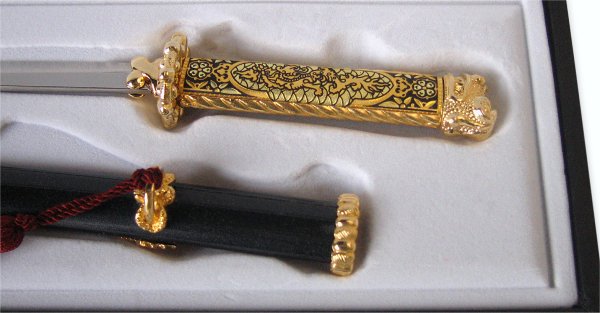The Damascene sword has more sincere reports than western media. Its essence is hair braids, its handle is the ivory strength, its color is silver purity, its decorations are golden surviving, its inscriptions are from the holy Quran, its makers are Damascene, and its lasting is forever.
“No sword, but Zulfiqar”
Between a handle and a sheath… its blade has glory:
The hilt of the Damascene sword is made either of elephant tusks “ivory”, or of buffalo horns, for the strength of these two objects and their agreement with the structure and shape of the blade. The sheath is made of walnut and beech wood. Precious metals are added to the Damascene sword through a process called “Altakfit” which is inserting strings of gold and silver to the surface of the blade, sheath, and handle, it is also decorated and studded with precious stones.
Substance, model, and decoration:
Substance: is a term used to indicate the phenomenon of overlapping lines of different colors, shapes, and conditions on blade pages.
They are smooth overlapping lines in the form of a fabric web, so either it divides the surface of the blade to spots and spaces or it forms harmonious and convergent knots, and it may be in the form of broad lines as meanders or parallel.
This difference depends on the percentage of the mixing of the steel dough, and the difference in temperature. The Damascene substance is characterized for the wonderful waves that look like geometrical spots, in addition to its colors that are slanted to white, its inability of rust, its softness, and its composition of soft grains colored in gray with tendency to white. Two of the most famous people who carved their names on their
swords are: “Asad Allah Aldimashqi” and “Qaleb Ali Aldimashqi” who were the most famous armed men in their time.
Decoration of the Damascene Sword:
Mr. Fouad Arbash, president of the verbatim association, says about the Damascene sword: “the engraving on the metal is one of the most important ones. The Damascene sword was able to save its Damascene identity through its substance, decoration, and type. The patterns and decorations were from the age that the sword is made in. floral and geometric adornments carved by the craftsman with a hammer and a chisel as it is pure handmade. The most famous writings engraved on swords are: the prophetic tradition “paradise is under the shade of swords” and the sentence of “there is no boy, but Ali and Braids, blades, and fingers: From the first moment you lay your eyes on the fence of old Damascus, you feel the charm captivating you that you can do nothing but sing to it. Enter from the Eastern Door then sidewalks, lamps, and shops will translate their stories with history for you. When you arrive to after the “Church of Mary” in a straight street, you must stop in front of a shop called “The Damascene Sword” enter it and you will be welcomed by Uncle Abu Ziad Alsyoufi who is one of the most famous sword makers remaining in the old city, you can ask him about the Damascene Sword as he is a rare crafts man, for you no longer find much people to ask. Travel Syria magazine asks him in his shop what you could ask him, and here are the details:
How is the Damascene sword made?
Mr. Syoufi says: “we braid the iron and steel wires according to the intended length, width, depth, and thickness of the sword, we enter the metal strand in the firehouse so it turns into a metal paste ready for beating and formatting, we get an initial sample of the blade so we start hammering it to determine the thickness, then comes the most important stage which is “refinement and reduction” which is done by passing the blade on a strong stone of basalt, and that is when the substance of the Damascene sword shows.”
Haifaa Mafalani

